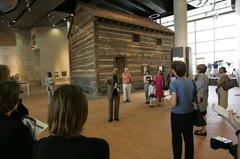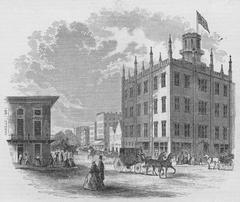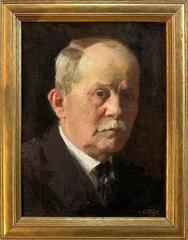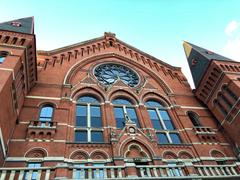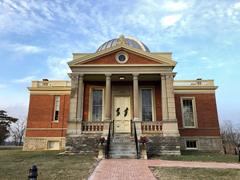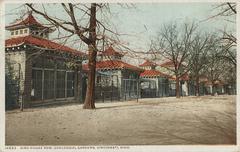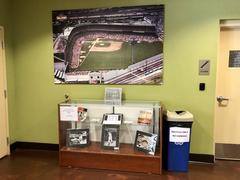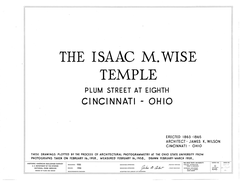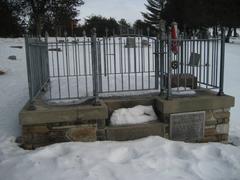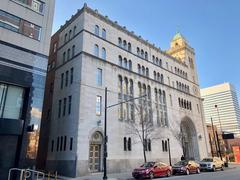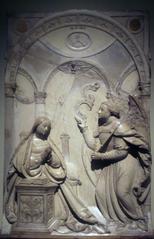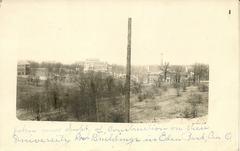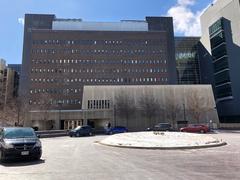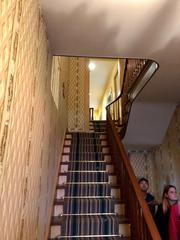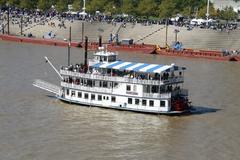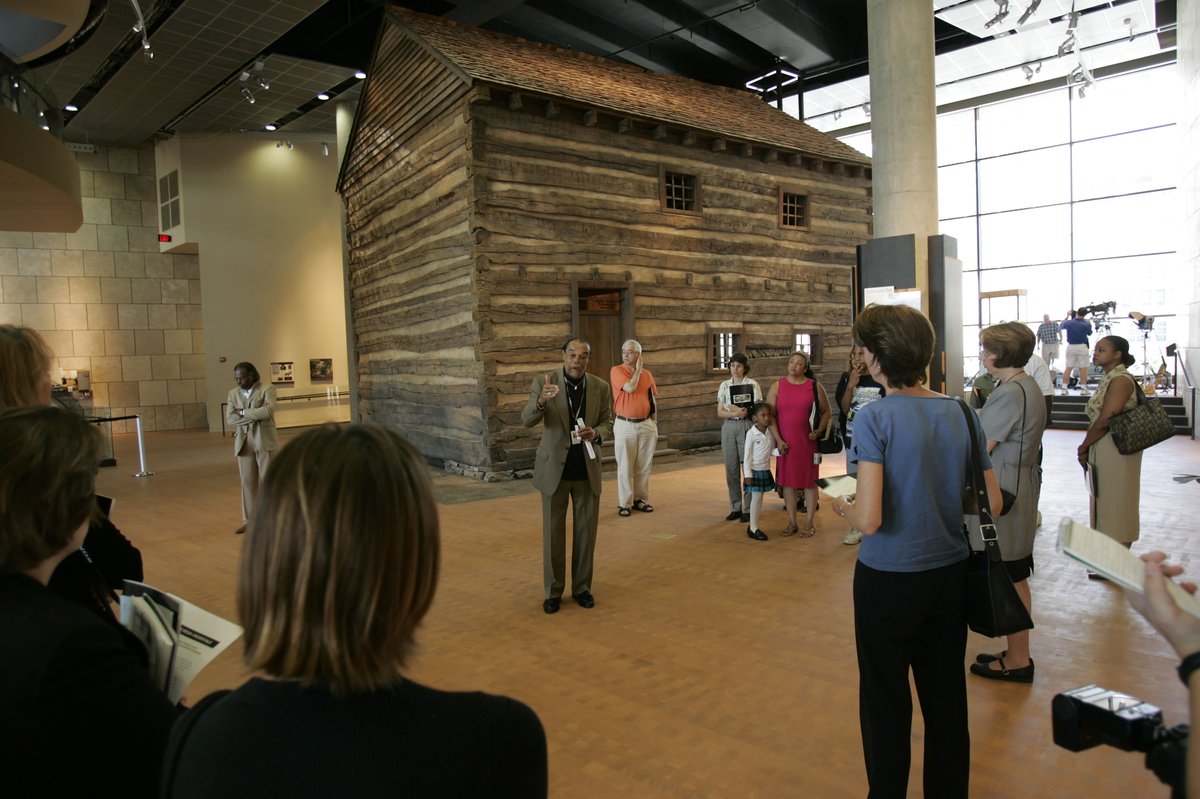
National Underground Railroad Freedom Center
National Underground Railroad Freedom Center: Visiting Hours, Tickets, and Cincinnati Historical Sites Guide
Date: 15/06/2025
Introduction
Situated on the historic banks of the Ohio River in Cincinnati, Ohio, the National Underground Railroad Freedom Center stands as a profound testament to the courageous individuals and communities that risked everything in pursuit of freedom. More than a museum, the Freedom Center is a vibrant educational and cultural institution dedicated to illuminating the complex history of the Underground Railroad—a secret network of routes and safe houses that helped enslaved African Americans escape bondage in the 18th and 19th centuries. Cincinnati’s strategic location along the border of slave and free states made it a critical gateway to liberty and a hub of abolitionist activity, underscored by the bravery of figures such as John P. Parker and Levi Coffin (Google Arts & Culture, The Voice of Black Cincinnati).
Since its opening in 2004, the Freedom Center has combined powerful storytelling with symbolic architecture, designed to represent the journey from oppression to liberation. Its three interconnected pavilions—courage, cooperation, and perseverance—along with immersive exhibits like the new “In This Place” gallery, provide a moving visitor experience that connects historical struggles with ongoing conversations about justice and equality (citydays.com, Movers & Makers).
This guide delivers essential visitor information, including updated visiting hours, ticketing details, accessibility, and tips for exploring nearby Cincinnati historical sites. It also highlights must-see exhibits such as the original 19th-century slave pen, interactive storytelling experiences, and educational programs for all ages. Whether you are planning a family outing, an educational field trip, or a reflective journey into America’s first multiracial human rights movement, this guide will help you make the most of your visit (Freedom Center official site, Adventure Mom Blog).
Table of Contents
- Introduction
- Historical Context and Significance
- Visiting Information
- Architectural and Exhibit Highlights
- Special Events and Community Engagement
- Nearby Cincinnati Historical Sites
- Frequently Asked Questions (FAQ)
- Summary & Call to Action
- Sources
Historical Context and Significance
The Underground Railroad: Origins and Operation
The Underground Railroad was a secret network of routes, safe houses, and courageous allies—both Black and white—established between the late 1700s and the Civil War to assist enslaved African Americans in their flight to freedom. The term is metaphorical: there were no trains or tunnels, but rather a coordinated effort by abolitionists, free Black communities, and sympathetic individuals who risked their lives and livelihoods to help others escape bondage (Google Arts & Culture). The Fugitive Slave Act of 1850, which imposed harsh penalties on those aiding escapees, made this work even more dangerous and underscored the courage of all involved.
Cincinnati’s Pivotal Role
Cincinnati’s location on the Ohio River made it a critical gateway to freedom. The river marked the border between slave states like Kentucky and free states like Ohio. For many freedom seekers, crossing it meant stepping onto free soil (Spectrum News 1). Cincinnati’s vibrant free Black community, active abolitionist organizations, and proximity to the South made it a hub for the Underground Railroad. Notable figures such as John P. Parker—an African American inventor and conductor—and Levi Coffin, known as the “President of the Underground Railroad,” operated in and around the city (The Voice of Black Cincinnati).
The Freedom Center’s Mission and Symbolism
Opened in 2004 at 50 East Freedom Way, the Freedom Center’s location is deeply symbolic, overlooking the Ohio River where countless enslaved people crossed into freedom (Spectrum News 1). The museum’s mission is to honor the legacy of the Underground Railroad and foster dialogue about freedom, racism, and ongoing struggles against modern-day slavery (Movers & Makers).
The Underground Railroad as a Human Rights Movement
Historians regard the Underground Railroad as America’s first multiracial, multi-class, and multi-ethnic human rights movement, with African Americans at its forefront (The Voice of Black Cincinnati). Figures such as Harriet Tubman, Sojourner Truth, William Still, and Henry “Box” Brown united across racial and social lines for justice (Google Arts & Culture).
Lasting Legacy and Modern Civil Rights
The Underground Railroad’s impact reverberated well beyond emancipation, influencing the Civil War, the 13th Amendment, and Juneteenth. The Center’s exhibits connect this legacy to ongoing movements for civil rights and justice, examining issues from Jim Crow to mass incarceration (Google Arts & Culture, Movers & Makers).
Everyday Life and Culture of the Enslaved
Exhibits highlight the resilience of enslaved people, showcasing family bonds, religious practices, music, and culinary legacies such as soul food. Spirituals offered both comfort and coded communication (Google Arts & Culture).
Artifacts and Personal Stories
The museum features a preserved 19th-century slave pen, original documents, and personal accounts that bring history to life and foster empathy across generations (WhichMuseum, Spectrum News 1).
Visiting Information
Hours & Admission
- Standard Hours: Wednesday–Sunday, 10:00 a.m. – 5:00 p.m.; closed Monday and Tuesday (Freedom Center official site)
- Special Events: Hours may extend on occasions like Juneteenth. Always check the official website for updates.
Tickets & Discounts
- General Admission: Adults $16.50, Seniors (60+) $14, Children (3–12) $11.50, Children under 3 free
- Discounts: Available for AAA members, active military, students, and educators
- Free Admission Days: Fifth and third Sunday each month, MLK Jr. Day, and Juneteenth (Juneteenth Jubilee details)
- Reservations: Strongly recommended, especially on free days and for group visits. Reserve online.
Guided Tours & Educational Programs
- Docent-led Tours: Available for groups by reservation; inquire on the official website.
- School Programs: Tailored educational experiences for students of all ages.
Accessibility
- Building: Fully ADA-compliant with elevators, ramps, and accessible restrooms
- Mobility Devices: Wheelchairs and ECVs available for rent at the front desk, first-come, first-served (The Voice of Black Cincinnati)
- Contact: Email [email protected] for special accommodations
Directions & Parking
- Address: 50 East Freedom Way, Cincinnati, OH 45202
- Public Transit: Cincinnati Bell Connector streetcar and METRO bus routes stop nearby (Adventure Mom Blog)
- Parking: Central Riverfront Garage at The Banks (closest); Fountain Square Garage (short walk); limited metered street parking (The Voice of Black Cincinnati)
Amenities
- Gift Shop: Sells educational books and fair trade gifts (Freedom Center Shop)
- Café: Onsite; outside food not permitted in exhibit spaces
- Restrooms: Accessible facilities on multiple levels
- Nursing Suites: Available for families
Visitor Tips
- Plan to spend 2–4 hours for a full experience
- Arrive early, especially during free admission days or special events
- Photography is allowed in most galleries (non-flash)
- Some content may be intense for younger children
Architectural and Exhibit Highlights
Symbolic Location & Design
The Freedom Center’s riverside location is intentional, overlooking the Ohio River—a historical boundary between slavery and freedom. Designed by Boora Architects and Blackburn Architects, the building’s undulating stone façade mimics the river’s currents, and its three pavilions symbolize courage, cooperation, and perseverance (citydays.com).
The Three Pavilions
Each pavilion represents a core value of the Underground Railroad and is connected by pathways that transition from darkness to light, reflecting the journey from enslavement to liberation.
Key Permanent Exhibits
- In This Place: Newly opened in 2025, this immersive gallery features panoramic media, historic photos, and interactive digital tables that let visitors explore Cincinnati’s abolitionist history (Movers & Makers)
- Slave Pen: A two-story, authentic structure from Kentucky, complete with iron shackles and personal accounts, offers a sobering glimpse into the realities of slavery (Adventure Mom Blog)
- ESCAPE! Freedom Seekers and the Underground Railroad: Interactive exhibit especially engaging for families, featuring role-playing and decision-making scenarios
- Brothers of the Borderland: A 25-minute immersive film about abolitionists John Parker and Rev. John Rankin
- Suite for Freedom: Introductory film illustrating the museum’s mission
Rotating Exhibitions & Upcoming Galleries
- Frequent special and traveling exhibitions address current topics in civil rights and social justice (Freedom Center events)
- Social Justice Gallery (Late 2027): Will explore systemic injustice and local-to-national activism
Special Events and Community Engagement
- Juneteenth Jubilee: Annual festival on June 19 featuring free admission, music, workshops, and a river march (Juneteenth Jubilee details)
- Fifth Third Community Days: Free admission on select Sundays each month
- Black History Month: February features performances, lectures, and workshops (FOX19 Black History Month Events)
Nearby Cincinnati Historical Sites
Enhance your visit by exploring other local attractions:
- Cincinnati Museum Center
- Harriet Beecher Stowe House
- Over-the-Rhine Historic District
- Smale Riverfront Park
- Taft Museum of Art
- Cincinnati Black Music Walk of Fame (Lewis & Clark Travel)
Frequently Asked Questions (FAQ)
Q: What are the Freedom Center’s visiting hours?
A: Wednesday–Sunday 10:00 a.m. – 5:00 p.m.; closed Monday and Tuesday. Special hours for events—check the official website.
Q: How much are tickets and can I reserve online?
A: Adult $16.50, Senior $14, Child (3–12) $11.50, under 3 free. Yes, reserve online (Freedom Center official site).
Q: Is the museum accessible?
A: Fully ADA-compliant; wheelchairs and ECVs available for rent.
Q: Are guided tours offered?
A: Yes, by reservation for groups and during special programming.
Q: Can I take photos inside?
A: Non-flash photography is allowed in most areas.
Q: What’s the best way to get there?
A: Use public transit, park at The Banks, or take the Cincinnati Bell Connector streetcar.
Summary and Call to Action
The National Underground Railroad Freedom Center offers a powerful, educational, and moving experience for all visitors. Its location on the Ohio River, immersive exhibits, and symbolic architecture make it an essential Cincinnati historical site. By visiting, you not only honor the legacy of freedom seekers and conductors but also support the ongoing mission for justice and equality. For the latest updates, tickets, and educational resources, download the Audiala app and follow the Freedom Center on social media.
Sources
- Google Arts & Culture – The Underground Railroad: National Underground Railroad Freedom Center
- citydays.com – National Underground Railroad Freedom Center
- Freedom Center official site – Plan Your Visit
- Freedom Center official site
- The Voice of Black Cincinnati – The Underground Railroad in Cincinnati
- Spectrum News 1 – Underground Railroad Freedom Center Second
- Movers & Makers – New Freedom Center Gallery Rooted in Power of Place
- WhichMuseum – National Underground Railroad Freedom Center
- Adventure Mom Blog – 10 Reasons to Visit the Freedom Center
- Lewis & Clark Travel – National Underground Railroad Freedom Center
- FOX19 Black History Month Events
